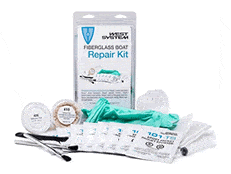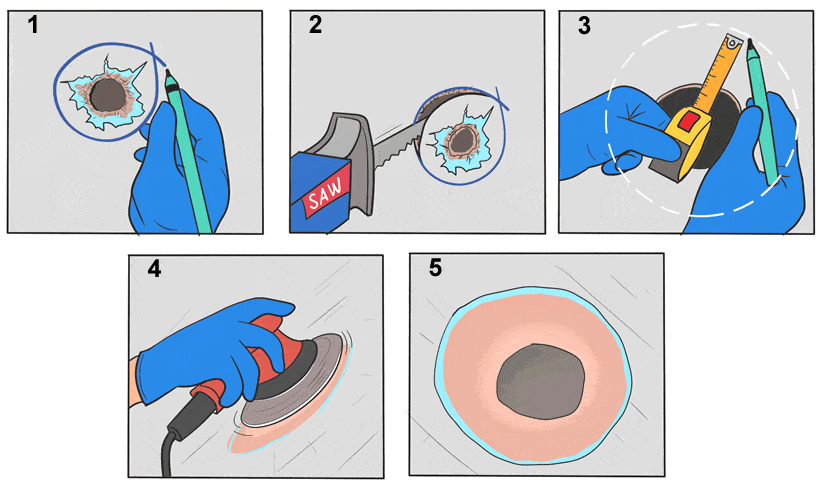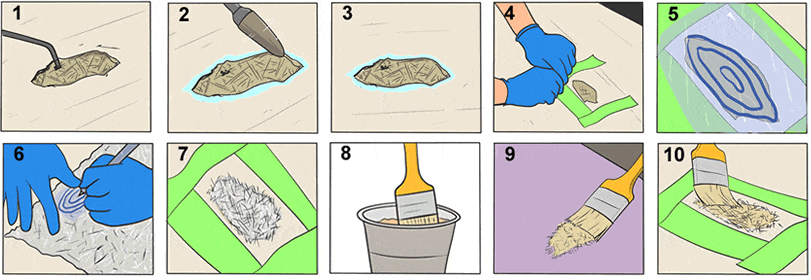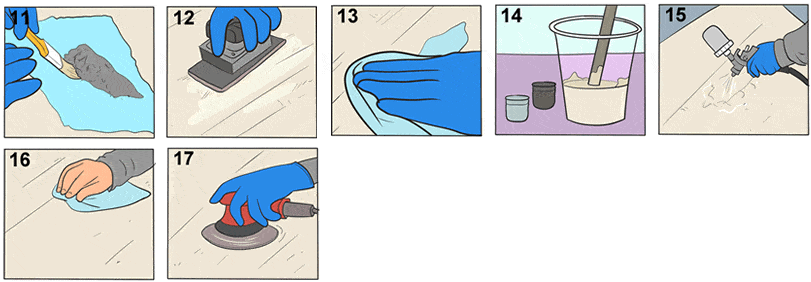How To Use Fiberglass Repair Kit
Nothing tin sink a gunkhole faster than a pigsty, and fifty-fifty the smallest hole could sink a ship. This is hopefully not something every gunkhole owner volition need to worry about, but information technology is a good idea to know how to fix a pigsty on a boat just in case the unthinkable always happens to you. If your boat springs a leak, y'all should take it out of the water right away and become it repaired before going dorsum out.
This past summer I was having java with a friend I hadn't seen since I was young, and I told him how I bought my first gunkhole recently. He started to tell me a story that has been stuck in my head ever since he told information technology to me. He told me how a few summers ago his family unit rented a cottage with friends of his, and the cottage came with admission to a gunkhole down at the dock. 1 of the teenage boys in the group had taken the gunkhole out and must have hit a rock or something, because the next day when they all went back down to the dock, there was about 8 inches of water in the boat. When the owner showed up he took the boat out of the water and pointed out stretches and a crevice in the bottom left side of the hull. Needless to say, that human volition probably never include his gunkhole for strangers to utilise again.
How Much Does Fiberglass Repair Cost?
The cost to repair fiberglass and gelcoat will vary depending on how much damage is done. Typically this price could range from $75 to $125, per hour in most places. Over again depending on how astringent the damage is, this could have anywhere from a few hours, to several hours. For case, chips and gouges can take a few hours, while an actual hole could have five to x hours.
You tin can choose to repair the damage yourself, and in well-nigh cases, it's a fairly piece of cake, straightforward procedure. If you have all of the tools needed, you could probably fix the repair for about $30 – $60 depending on how severe the impairment is.
Fiberglass Boat Repair Kit
 If your fiberglass repair is non too large, y'all can get away with ownership a repair kit to gear up the problem yourself. In that location is a fiberglass repair kit on Amazon chosen W System 105-Chiliad Fiberglass Gunkhole Repair Kit that is great for repairing cracks, scraps, gelcoat blisters, loose hardware, damaged keels and smaller holes under 1″ in diameter. The package comes with everything you will demand to perform the repair, besides as detailed instructions on how to utilize the product.
If your fiberglass repair is non too large, y'all can get away with ownership a repair kit to gear up the problem yourself. In that location is a fiberglass repair kit on Amazon chosen W System 105-Chiliad Fiberglass Gunkhole Repair Kit that is great for repairing cracks, scraps, gelcoat blisters, loose hardware, damaged keels and smaller holes under 1″ in diameter. The package comes with everything you will demand to perform the repair, besides as detailed instructions on how to utilize the product.
Currently, Amazon is selling this repair kit for $34.26 every bit of the time I am writing this. Click here to cheque the current price.
What is Gelcoat For Boats?
The gelcoat on a boat is the outer surface layer on a fiberglass gunkhole hull, which is designed to protect the bottom layers of fiberglass, and give your gunkhole that color and smoothen finish. The gelcoat is fabricated up of special polyester resin and fiberglass, or epoxy resin which is typically used with carbon fiber for extra strength and water-resistance.
Simply similar whatever other end, gelcoat is prone to scratches, chips, and deterioration. You might notice that over time your gelcoat might start to prove 'spider spider web' looking cracks which would betoken a weakness in the underlying fiberglass. Some other problem you might notice with the gelcoat is blistering, which generally means that at that place is a water intrusion nether the gelcoat itself.
Most of the time the repairs to gelcoat scratches, cracks, and fries are a pretty straightforward repair that can generally be fixed using a gelcoat paste. It's an easy job that can exist performed by nigh anyone, and really only requires a repair kit. The trickiest part is the sanding and polishing that'due south required to blend the area with the hull.
How Do You Get Scratches Out of Gelcoat?
If your scratches are on the surface of the gelcoat, then those tin be buffed out using a polishing compound, but if the scratches are deep they'll demand to exist filled in. Usually if the surrounding gelcoat is in good condition, y'all can use a gelcoat paste to fill in the scratches. Considering the surface of the cured gelcoat paste volition be uneven, y'all volition need to sand and smoothen the repair area.
What you will demand:
Kickoff, yous are going to need a gelcoat paste that tin can be picked up in a repair kit for less than $35. The kit should come with the gelcoat paste and hardener, selection of pigments, mixing sticks, and sealing movie. You volition likewise demand to buy a single sheet of 150-, 220-, 400-, and 600-dust wet-or-dry sandpaper, and a flexible plastic spreader if you don't already take one.
Matching the colour:
Matching the colour is going to be the toughest part of the repair. Many experts tin can tell you that it's very difficult to perfectly match the colour on a boat that'southward been in the sun for a few years. White is typically a fiddling easier to effort matching, information technology's more different when yous starting time to get into colored hulls.
You lot can get a color-sample card from your local paint supply store that all-time matches your hull. Once you lot know which color-sample best matches, you can then inquire the shop clerk for the color formula used to create this specific color alloy. With that data, you lot can so endeavour to recreate the aforementioned color combination using the tints that came in your repair kit.
Prepare the scratch:
Earlier you lot start to apply the gelcoat paste to the scratch, have a screwdriver and run it down the scratch to open up it up a little wider into a 5 shape. The reason for this is because the gelcoat paste is very thin and if it'south applied over the scratch then it'll but end up forming a bridge over the scratch leaving a void under the newly applied gelcoat paste.
Use Hardener:
To employ the hardener, make sure to read and follow the manufacturer'southward instructions. Typically as a full general dominion, four drops of hardener will catalyze one ounce of resin at one percent. It'due south better to add too piffling than too much hardener. The mix shouldn't first to harden in less than 30 minutes. Hardening should take about two hours.
Apply the gelcoat paste:
Using a flexible plastic spreader, begin to work the gelcoat paste into the scratch. While applying the gelcoat paste, keep in mind that polyester resin will compress slightly as information technology cures, so yous'll want to have the paste stick out a trivial from within the scratch. Remember you will be sanding this once it's cured so it'll exist okay to put a little extra on. Don't put too much actress, because that'll create actress work for you lot when sanding.
Embrace the repair area:
Gelcoat does not fully cure unless it'south covered upward with a plastic sheet. Your repair kit might accept come with a plastic moving picture that you'll have to use to cover the repair area. If yous didn't receive a plastic moving-picture show with the repair kit, you can utilize some Saran Wrap or a plastic sandwich bag. Beginning first by taping ane side down to the surface merely beside the repair, then smooth out the plastic onto the gelcoat and tape downwards the remaining sides. Let the plastic sit for at to the lowest degree 24 hours.
Sanding and polishing:
Once you lot've waited over 24 hours, you can remove the tape and plastic. Using a sanding block and a canvas of 150-grit sandpaper, begin to sand out the new department of gelcoat. For this, you'll want to take your fourth dimension and make sure you are only sanding the new patch of gelcoat and not the old surrounding gelcoat surfaces. Using a sanding cake will assist you keep the sanding confined to the repair surface area.
Once the new gelcoat has been sanded down and it's now flush, switch to 220-dust wet-or-dry sandpaper. Proceed to wet sand the repair, keeping your sanding block flat the whole time. For this, you are going to accept to keep a deadening drizzle of water running on the sanding area, while you sand the repair in a round motion. Every so often, stop sanding and accept your finger and run it over the repair expanse feeling for the ridge. End sanding when y'all can no longer feel a surrounding ridge.
Without using the sanding block anymore, switch over to a 400-grit wet-or-dry out paper. Begin to sand the repair some more than using water, until the repair area has a uniform appearance. Switch to a 600-grit moisture-or-dry newspaper and continue sanding with water trickling over the repair for just a little longer.
Dry out the water off using a soft cloth. Use a rubbing compound to assistance give the gelcoat a nice loftier gloss look. Apply the compound over a soft cloth, and brainstorm to vitrify it over the surface of the repair surface area with a circular motion, first by using heavy pressure, then gradually reducing the pressure level until the surface becomes glassy looking. If you are still able to see swirl marks in the gelcoat, proceed to buff them out using a very fine finishing compound.
Finishing impact:
One time you accept finished buffing out the terminal of the swirl marks in the gelcoat, yous tin can at present give the area a waxing. If you were able to match upward the color properly, and then in one case you are finished, the repair area should be hard to discover.
Repair small-scale hole in a fiberglass boat hull
Hole going right through fiberglass into the boat:

- Commencement, examine the hole and look for cracks and chips extending out from the hole. Utilize a marker to circle the entire damaged expanse. Making certain to include the cracked spots.
- Next, take a saw and cut out the damaged area that you've circled with the marker.
- Now that the holes cut out, you need to decide the thickness of the hull substrate and multiply that by 10. This will give you a circumference effectually the hole that you'll demand to bevel down. Accept a measuring tape and marking to outline that distance around the pigsty.
- Using a power sander with a fifty grit sanding disc, you tin at present bevel the whole border out to your mark.
- Once you've finished bevelling the expanse, you now need to discover something to become in backside the hole to block it. Some people utilise Ducktape for this or a slice of woods with plastic wrap over it.
You can at present follow the steps beneath starting on #iv to patch upwardly the hole.
Croaky couple layers of fiberglass, not quite through into the gunkhole:


- Chip away any loose fiberglass from around the pigsty.
- Next, take a small grinder and smooth the edges of the hole, also as the exposed fiberglass.
- After you lot've basis the area, you lot should at present be down to the solid laminate.
- Using a painters record, place the tape effectually the hole to avoid getting access resin on other parts of the hull.
- Take a clear piece of plastic and place it over the hole. At present using a marker, trace around the edges of the hole. Side by side, come in a little from the edge and trace the outline out once again. Finally over again, inside that outline, coming in a little more, trace effectually the hole one more time. You should accept iii outlines of the hole, that will expect like the rings on a tree stump.
- Side by side, cutting out the larger outline start, and than trace that onto the new sheet of fiberglass. Once you lot've cut the fiberglass out, cutting the next size outline out of the plastic and trace that on the fiberglass. Exercise this until y'all have all 3 outlines of the fiberglass cut out.
- Stack the pieces in the void that you lot ground out on the hull (putting the smallest size down start and working up) and check if the acme will exist good, or if you need to add one more layer. Most of the time you tin can get abroad with 3 layers, but adding an boosted layer wouldn't hurt. It would but mean actress sanding if it was besides high.
- Next, mix up the vinyl ester resin and hardener in a small plastic container. Mix it up really good.
- Take a paintbrush and carefully moisture each piece, forepart, and dorsum.
- Take the pieces, 1 at a time and identify them in the void. Start with the smallest size first and working up. Using your paintbrush, carefully spread them out getting rid of any air pockets or wrinkles acquired by placing them down.
- Afterward the terminal slice is added, remove the surrounding record, and then take some peel ply and identify it over the repair. Using your paintbrush, carefully dab it around the pare ply and spread it out. Then allow it sit down for about an hour.
- Afterward an hr, you can so take a sander and slowly sand the area smooth.
- One time yous've finished sanding the repair, clean the area with some acetone.
- This is where things get a little tricky. Mix upward a batch of gel coat, trying to match the existing hull color.
- In one case yous think yous have the aforementioned color, it's time to utilise the pigment to the repair spot. Using a spray nozzle is easiest.
- One time the gel glaze is hardened, take some acetone and wipe the expanse clean.
- Finally, perform some wet sanding to the area to help transition the repair to the residuum of the hull and give it that natural look.
Source: https://boatingforbeginners.com/fix-a-hole-on-a-fiberglass-boat/

0 Response to "How To Use Fiberglass Repair Kit"
Post a Comment